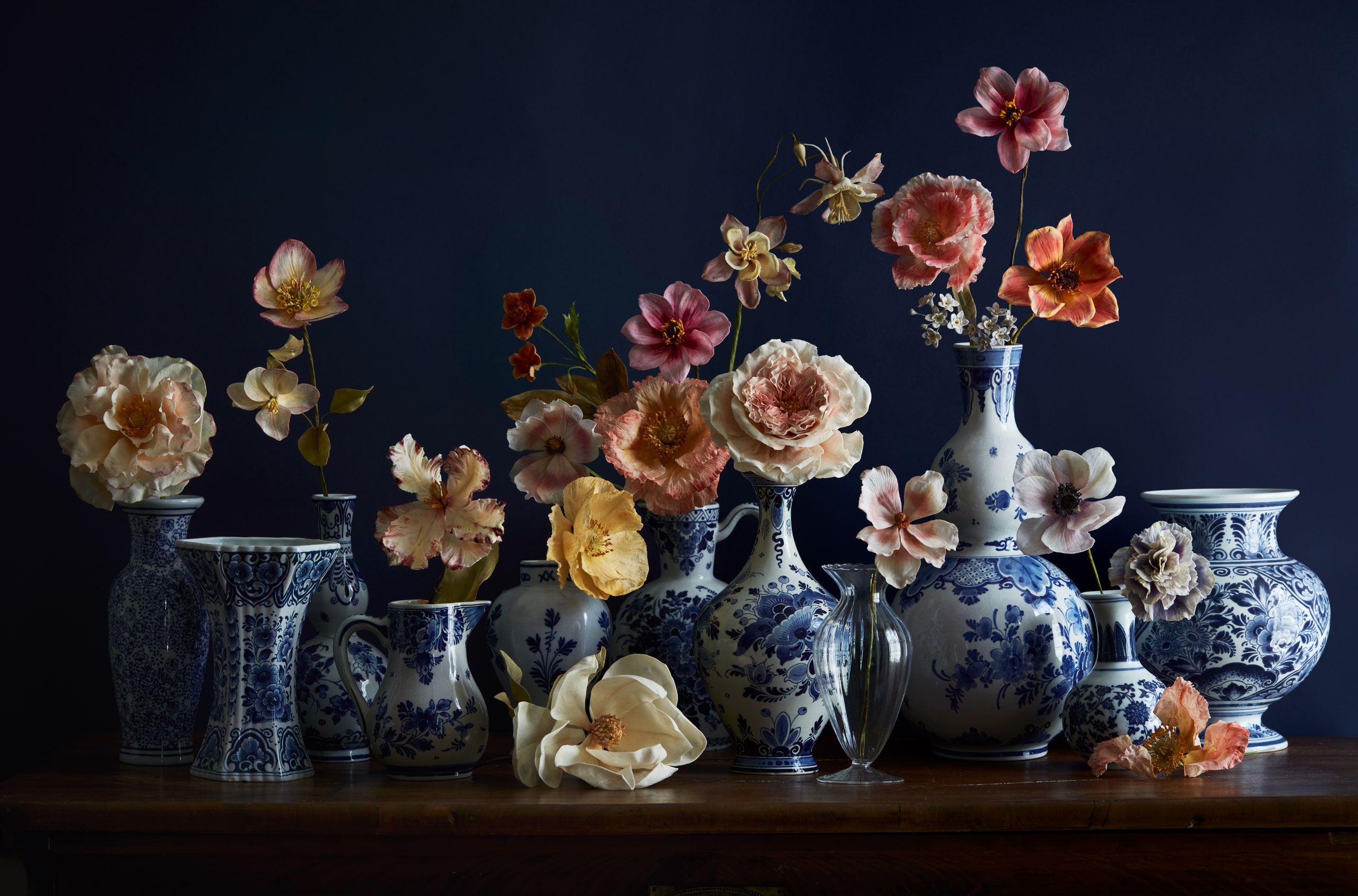A fortnight had passed since her daughter Nora’s fifth birthday – and yet the Suriname-born Dutch bridal-wear designer Natasja Sadi still found herself glued to the kitchen table surrounded by piles of wafer-thin rose, coral and magenta sugar petals, and modelled anthers ready to be dusted with edible pollen. In the baking and decorating of a special cake, Natasja had discovered her talent for conjuring confections as life-like as any entity from Amsterdam’s Saturday flower market. ‘Powdered sugar was a potent commodity in my family history and I gradually grasped the deeper significance of my chosen medium.’
Natasja, a descendant of both African slaves and Indonesian contract workers, has cultivated a life for herself that pays homage to her ancestors, whose toil on the sugar plantations of Dutch Guiana fuelled the Golden Age of 17th-century flower painters. For many years, she’d found herself drawn time and again to the masterpieces in the Rijksmuseum by Rachel Ruysch and Maria Sibylla Merian – today, their lives and work remain her greatest influences. In botany, a dichotomy is the repeated branching of a plant into two equal parts; in this vein, Natasja seems to have succeeded in fusing together the dichotomy that resides at the core of her concoctions.
Natasja, her husband Michaël van Heusden, a creative director, and their children, Jan and Nora, live in Amsterdam on the top floors of an 18th-century merchant’s house on the Singel, where buildings lean over the ancient canal in a wonky procession of age and style. You leave the chatter of the gulls and the sparkly dancing shadows of towering embankment elms to enter a brilliant white hall, with panels edged in rococo swirls that could have been squeezed from a giant piping bag. It’s the perfect entrance from which to follow the scent of vanilla-infused baking up a twisting elliptical staircase, emerging into a bright enfilade of long-windowed rooms. Carrying on heavenward, a guest will then reach a roof terrace with a bird’s-eye view of Amsterdam, and the cornucopia of potted plants that Natasja tends as she listens to the pealing bells of Westerkerk.
Dedicated to observing every stage of a flower’s journey from bud to decay, Natasja takes regular snippets from her outdoor garden to serve as models, alongside market flowers, for the edible garden within. Situated beside the kitchen (whose surfaces double as a studio for the artist), the couple’s office, indeed, is a botanical sugar Wunderkammer. Shelves of jostling specimens look like a dream assortment of fresh flowers, some impeccably conditioned for an arrangement, others with a naturalistic semi-wilting gait. Everything is unbelievably true to life in form and colour.
A cluster of Rembrandt tulips, with their particular bendy stems, flame markings and pollen colour, is recognisable as a specific cultivar. There are peonies with a thousand stamens, opium and field poppies, ‘Centifolia’ roses and hybrid teas, ‘Pom Pom’ and ‘Dinner Plate’ dahlias, ranunculus, anemones and aquilegia. The hellebores! Your brain conjures the scent of confectionery lemon Magnolia grandiflora would achieve in Natasja’s hands.
In her words: ‘Any expression or gesture a flower can convey in a vase can be captured in sugar.’ Vases of flowers greet you in every room, from giant arrangements of cleverly dried combinations to jars with a single bloom. Each moment is forensically observed until the time is right to whisk the egg whites and add the sugar. In the spirit of Rachel Ruysch, who ‘painted the most extraordinary fictitious still lifes of bouquets spilling with flowers from all seasons’, Natasja plucks anomalous characters from her sugar garden to add an incongruous twist to her large fresh and seasonal weekend arrangements – which now have a global audience on Instagram. Cakes, photography, favourite delft vases and her sugar flowers are often combined in a crescendo of colour and indulgence – all of which starts with a visit to the Saturday flower market.
Natasja now travels the world baking, arranging and teaching, but her most treasured moments are back in that kitchen on the Singel, fashioning nature from powdered sugar and reflecting on the difference between her circumstances and those of her great-grand-parents, lured away from their homeland in Indonesia with broken promises. ‘My mother and I have made many visits to Suriname – following in the footsteps of both my ancestors and Maria Sibylla Merian.’ On the site of one of the former plantations, in punishing heat and humidity, they found some half-buried green glass bottles poking out of the mud. ‘The water these contained was all they had for backbreaking days cutting sugar cane.’ The bottles came home with her and now reside garlanded by floral tributes, both real and sculpted, in the former canal home of a wealthy merchant. As Natasja says in the opening chapter of her book, A Sweet Floral Life: ‘Creating sugar flowers and floral arrangements in the Dutch style has been one way of breaking uncomfortable habits of silence.’ Disarmingly, powerfully, beautifully.
Instagram content
This content can also be viewed on the site it originates from.
To contact Natasja Sadi, visit natasjasadi.com
